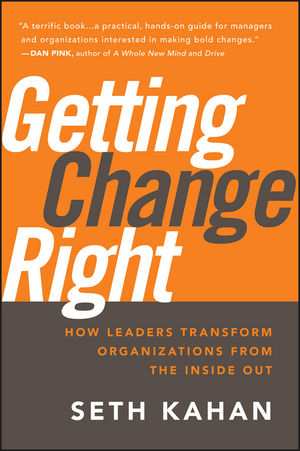Getting Change Right: How Leaders Transform Organizations from the Inside OutISBN: 978-0-470-55048-9
Hardcover
256 pages
May 2010, Jossey-Bass
 This is a Print-on-Demand title. It will be printed specifically to fill your order. Please allow an additional 10-15 days delivery time. The book is not returnable.
|
||||||
Connect with Wiley Publicity
Change has become a term that is carelessly thrown around to inspire people and give them hope for something better, yet too often change fails to implement. Seth Kahan has seen this happen too many times in his successful career as a trainer and consultant, and recognized that a major paradigm shift needed to occur for change to change.
Getting Change Right (Jossey-Bass; $27.95; May 2010) presents a new view of leadership communication that says change doesn't flow top-down, bottom-up, or sideways, but inside-out. When the right people are having the right conversations and interactions, then they act in concert even though the situations they confront independently are impossible to predict or coordinate. This is how change spreads through a complex system.
“With Getting Change Right, I’m hoping to challenge readers with a new model of communication, one that moves from a transactional view of information exchange to a collaborative construction of shared understanding,” explains Kahan, who writes the Leading Change blog for Fast Company. “Instead of presenting a message and hoping it arrives, I propose that we talk together to recognize what this will mean to each of us.” This shift in leadership communication forms the basis of Getting Change Right.
Kahan's experience with Fortune 100 companies, leading government agencies, and innovative associations has shown him that there is a whole different way to approach change that leads to dramatic success. It feeds on authentic face-to-face conversations among those whose understanding and behavior has critical impact, as well as dramatic events that capture the spirit of the change and spread it in powerful surges. This approach is just as much about listening as it is about telling – a process Kahan calls co-creation.



